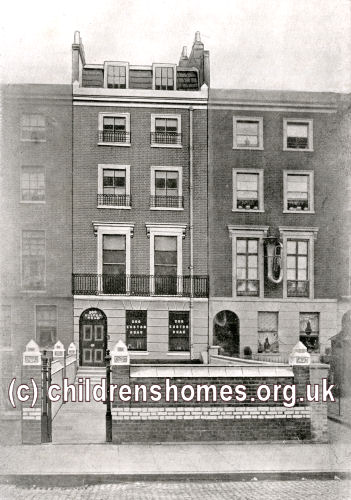The London Female Preventive and Reformatory Institution, St Pancras, London
The London Female Preventive and Reformatory Institution (LFPRI) was founded in June, 1857, effectively as merger of the work previously carried out by two organisations known as the London Female Dormitory and the Female Temporary Home. The Female Dormitory, which was supervised by a 'Christian widow', provided 'family home' style accommodation for 'fallen' women, in contrast to the severe regime which existed in many 'penitentiaries' of the day. The Temporary Home performed a similar role but for women 'who had received a superior education'. It also aimed to have a preventive function in offering free or low-cost accommodation to women who were unemployed or between situations.
The new scheme was instigated by Lieutenant John Blackmore who had previously been prominent in the activities of both bodies. He was assisted by Mr Edward William Thomas, who had previously been involved in Blackmore's mission work, and the 'Christian widow' who had by now become Mrs Maria Thomas. Edward Thomas became the Institution's Secretary, a position he held until his death in 1893.
LFPRI's first premises were opened in 1857 at 26 Grafton Place, Euston Square, with the Thomases acting as superintendent and matron. The house had sixteen places and due to its limited space, both preventive and reformatory cases were together under the same roof. In the early, money was very short. Mrs Thomas received no salary for her work, and during the first six months Mr Thomas contributed £10 towards the rent of the home, plus £12 towards the board of his wife and himself, as well as freely giving his own services.
A few months later, a gift from a benefactor who had visited the home enabled the Committee to look for larger premises. In 1858, the Institution took on the rental of 200 Euston Road, which became its Central Home and Headquarters. A lease on the property and then its freehold were subsequently acquired.

London Female Preventive and Reformatory Institution, 200 Euston Road, c.1905. © Peter Higginbotham
Further Homes were subsequently established in properties around London, some used for just a few years. The locations included:
- 35 Eden Grave, Holloway (1859)
- 5 Parson's Green, Fulham (1860)
- 26 St James' Place, Old Kent Road, Southwark (by 1862)
- New Cross Road (c.1863)
- 195 Hampstead Road, St Pancras (1865)
- 5 Camden Street, Camden Town (c.1866)
- 7 Parson's Green, Fulham (1867)
- 26 Fitzroy Place, Fitzrovia (1868)
- Milton House, 1 Maude Grove, Chelsea (1871)
- 37 Manchester Street, King's Cross (1872)
- 459-461 Holloway Road, Holloway (by 1890)
In the 1880s, LFPRI's objects were formally stated as: "To seek the destitute and fallen by voluntary missionary effort; to afford temporary protection to friendless young women whose circumstances expose them to danger; to rescue fallen females, especially those decoyed from the country; to restore, when practicable, the wanderer to her family and friends, whether in town or country." Admission was by voluntary application at 200 Euston Road, where inquiries were made as to eligibility of applicants, and, if suitable, they were admitted — at once, if possible — and sent to the Home best adapted for them. Inmates were employed in housework, needlework, washing etc. up until 7 p.m., at discretion of matron. Time was also allowed for self-improvement, such as writing and reading.
In the 1920s, LFPRI moved its headquarters to 3-4 Liverpool Street (now renamed Birkenhead Street), formerly part of its All Night Refuge premises. LFPRI also took over the work of another 'rescue' organisation, the Midnight Meeting Movement, founded in 1859 and in which Edward and Maria Thomas had been closely involved.
In 1939, the Institution's homes included:
- Open All Night Refuge, 2 Liverpool Street (c.1910)
- The Hermitage / Newhaven House, 272 Colney Hatch Lane, New Southgate (by 1912)
- Mill House, Windmill Road, Mitcham Common
Its aims were now "to train destitute friendless girls for domestic service; to shelter virtuous young women in circumstances of moral peril; to seek and reclaim the betrayed and outcast." Reconciliations were effected with relatives.
After the Second World War, LFPRI changed its name to the London Haven for Women and Girls. Due to financial problems, the organisation was wound up in 1976, with its remaining assets being passed to the Rainer Foundation which later became part of Catch22 — "a social business providing services that help people in tough situations to turn their lives around".
Records
Note: many repositories impose a closure period of up to 100 years for records identifying individuals. Before travelling a long distance, always check that the records you want to consult will be available.
- Galleries of Justice, Wolfson Study Centre, The Shire Hall, Lace Market, Nottingham NG1 1HN. Holds Rainer Foundation archives which include LFPRI material.
- The
Ancestry UK
website has two collections of London workhouse records (both name searchable):
- The Find My Past website has workhouse / poor law records for Westminster.
- London Metropolitan Archives, 40 Northampton Road, London EC1R OHB. Has some records from 200 Euston Road (1907-47). The LMA catalogue notes "previous papers in parcel now missing".
Bibliography
- Thomas, E.W. Twenty-Five Years' Labour Among the Friendless and Fallen (1897)
- Taylor, W.J. The Story of the Homes (1907)
- Bartley, Paula Prostitution: Prevention and Reform in England, 1860-1914 (2000, Routledge)
- Finnegan, Frances Poverty and Prostitution: A Study of Victorian Prostitutes in York (1979, CUP)
- Hopkins, Jane Ellice, Work Among the Lost (1870, William Macintosh) Nokes, Harriet Twenty-Three Years in a House of Mercy (1886, Rivingtons)
- Taylor, William J The Story of the Homes (1907, London Female Preventive and Reformatory Institution)
- Thomas, E W Twenty-Five Years' Labour Among the Friendless and Fallen (1897, Shaw)
Links
Except where indicated, this page () © Peter Higginbotham. Contents may not be reproduced without permission.


